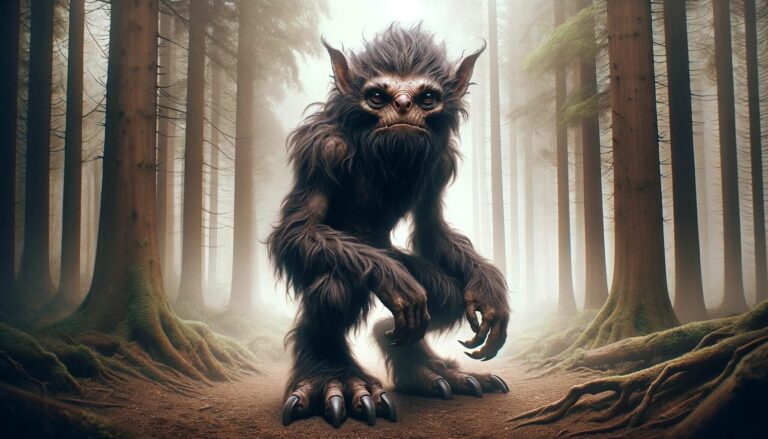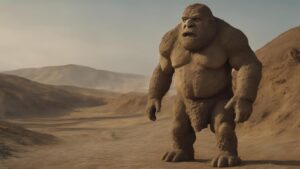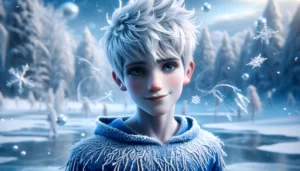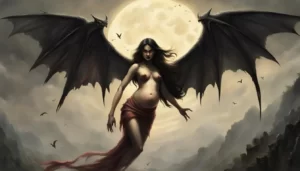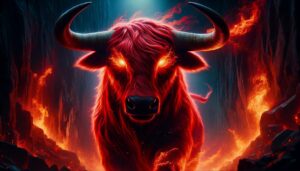Table of Contents
In the vast realm of mythical creatures, there are those that inspire awe, others that invoke fear, and then there are the enigmatic beings known as Pukwudgies. These diminutive creatures have long captured the imagination of those who delve into the fascinating world of myths and legends. With origins deeply rooted in Native American folklore, Pukwudgies are not your ordinary mythical creatures. Shrouded in mystery, Pukwudgies embody a unique blend of traits, stories, and symbolism, rendering them a captivating subject for exploration.
Ištakos ir kultūrinė reikšmė
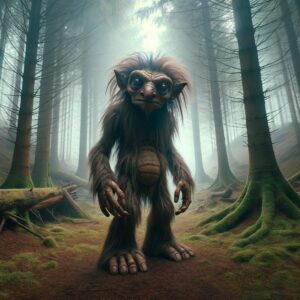
Pukwudgies find their origins in the folklore of several Native American tribes, particularly the Wampanoag people of the northeastern United States and the Algonquian-speaking tribes of the Great Lakes region. The word “Pukwudgie” itself is believed to be derived from the Wampanoag language, with various interpretations of its meaning, including “person of the wilderness” or “little wild man of the woods.” This etymological ambiguity mirrors the elusive nature of these creatures themselves.
Native American cultures often perceive Pukwudgies as beings that embody both mischievousness and danger. These elusive creatures inhabit remote wilderness areas, dense forests, and secluded swamps, considering these regions as their domains. Venturing too close to their territory can result in trouble. Some legends portray Pukwudgies as protectors of the forests and guardians of certain natural wonders, while others depict them as malevolent tricksters who delight in causing harm.
Physical Appearance
Typically, people describe Pukwudgies as small humanoid creatures, standing at about two to three feet in height. Different tribal legends slightly vary in their portrayal of their physical appearance, but they commonly feature a stocky build, grayish or bluish skin, and a distinctive large nose. Their eyes, in these descriptions, frequently glow and pierce, further contributing to their eerie aura. Pukwudgies gain recognition for their agility and swiftness, allowing them to effortlessly navigate the dense forests they consider home.
One of the most distinctive features of a Pukwudgie is its long, sharp fingers. These fingers serve various purposes, from crafting arrows and weapons to playing tricks on unsuspecting travelers. Some legends also describe Pukwudgies as having quills or spines on their backs, which they can shoot like arrows to harm or defend themselves when threatened.
Gebėjimai ir galios
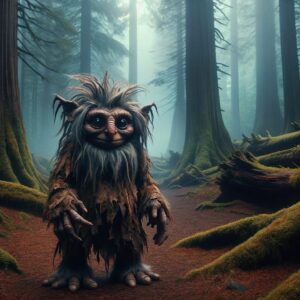
Pukwudgies possess a range of supernatural abilities, rendering them formidable and unpredictable beings in Native American mythology. These abilities, intricately tied to their dual nature as both protectors and tricksters, include:
Firstly, shapeshifting, as Pukwudgies are believed to have the power to transform into different shapes and sizes. This remarkable ability allows them to seamlessly blend into their surroundings or assume various forms to confound or deceive those who cross their path.
Additionally, there is the power of invisibility, a feature found in some legends, where Pukwudgies can become invisible at will, rendering themselves nearly impossible to detect by ordinary means.
Moreover, they are credited with mind control, with stories suggesting that these creatures possess a degree of control over human thoughts and emotions. This power enables them to manipulate the minds of those they encounter, further amplifying their mystique.
Another intriguing ability attributed to Pukwudgies is fire manipulation. These enigmatic beings associate themselves with fire and possess the capacity to create and control flames. They can harness this power for either protection or to sow chaos, depending on their prevailing mood.
Lastly, there is their uncanny talent for mimicry, a skill that Pukwudgies are renowned for. They are adept at mimicking human voices, animal sounds, and other natural noises with remarkable accuracy. This mimicry serves as a potent tool for confusing and disorienting their unsuspecting victims, adding to the aura of intrigue that surrounds these elusive beings.
Symbols and Representations
The symbolism surrounding Pukwudgies is as complex and multifaceted as the creatures themselves. Certain Native American cultures perceive Pukwudgies as symbols that represent the delicate balance between the natural world and the spirit realm. As a result, they hold these beings in reverence as guardians of sacred places and often interweave them with the spirits of the forest.
The Pukwudgie’s long fingers and sharp quills are symbolic of their duality as protectors and tricksters. These attributes represent their ability to both defend the wilderness and play tricks on those who enter their territory.
Myths and Stories
The Creation of Pukwudgies
According to the rich tapestry of Wampanoag legend, Pukwudgies owe their existence to Maushop, a colossal giant who once roamed the earth. In his benevolence, Maushop crafted these diminutive beings, the Pukwudgies, with the noble intention of providing companionship to humanity. However, as the Pukwudgies continued to evolve, a darker aspect of their nature began to emerge. Their mischievous tendencies and unruliness eventually led them to rebel against their very creator.
Pukwudgies and the Hunter
Within the mosaic of Algonquian lore, we encounter a fascinating tale of a skilled hunter who crossed paths with a Pukwudgie deep within the woods. This curious creature, intrigued by the hunter’s remarkable prowess, seized the opportunity to initiate a contest of skill. In this enthralling encounter, the hunter’s wits and ingenuity prevailed, outsmarting the cunning Pukwudgie. This triumph not only earned the hunter the creature’s respect but also secured his safe passage through the densely forested realm.
Pukwudgies as Mischievous Tricksters
Throughout the annals of folklore, Pukwudgies consistently emerge as mischievous tricksters. They are endowed with a penchant for playing pranks that range from light-hearted jests to more malevolent deeds. Their capricious behavior, as we observe, depends entirely on their ever-shifting moods, rendering them enigmatic and unpredictable figures in the realm of mythical creatures. Furthermore, these devious antics add an element of whimsy and danger, injecting intrigue into the narratives surrounding Pukwudgies.
Pukwudgies as Forest Guardians
In stark contrast to their playful trickster personas, certain myths cast Pukwudgies in the role of stalwart guardians of the forest and its inhabitants. Moreover, these legends weave a tapestry of reverence, artfully depicting Pukwudgies as protectors of sacred places and stalwart defenders of the natural world. In this pivotal role, they serve as the guardians of the delicate balance that exists between the realm of humanity and the untamed wilderness, symbolizing the profound connection between humans and the environment.
Similarities
Pukwudgies do share similarities with other mythical creatures from various cultural traditions. While they have their distinct characteristics, their roles and traits can draw comparisons to other legendary beings. Here are a few examples:
Leprechauns (Irish Folklore): Pukwudgies’ mischievous and sometimes malevolent nature draws parallels with leprechauns from Irish folklore. Both are known for their love of pranks and tricks on humans, often with a playful or mischievous intent.
Goblins (European Folklore): Like goblins in European folklore, Pukwudgies are often associated with wild and remote areas, where they can be either benevolent or malevolent. They share a common theme of being supernatural beings inhabiting the wilderness.
Sprites and Fairies (Various Folklore): Pukwudgies’ ability to shapeshift and their connection to nature align them with various sprites and fairies found in folklore worldwide. These creatures often have dual natures as protectors of nature and tricksters.
Hobgoblins (English Folklore): Hobgoblins are known for their dual roles as helpful household spirits or malicious troublemakers. This duality mirrors the Pukwudgies’ nature as protectors and tricksters, depending on the circumstances.
Trickster Figures (Various Cultures): Pukwudgies also share characteristics with trickster figures found in many cultures, such as the Native American Coyote or the Norse Loki. These beings are known for their cunning and unpredictable behavior, often causing both chaos and enlightenment.
FAQ
Where are Pukwudgies believed to live?
Pukwudgies are said to inhabit remote wilderness areas, dense forests, and secluded swamps, primarily in the northeastern United States and Great Lakes region.
Do Pukwudgies have supernatural abilities?
Yes, Pukwudgies are attributed with supernatural powers, including shapeshifting, invisibility, mind control, fire manipulation, and mimicry.
Are Pukwudgies considered dangerous?
Pukwudgies are viewed as both mischievous and potentially dangerous beings. It's best to be cautious when encountering them, as their behavior can vary.
What is the origin of Pukwudgies?
According to some Native American legends, Pukwudgies were created by Maushop, a giant, to be companions for humans. However, they later turned rebellious.
What role do Pukwudgies play in Native American mythology?
Pukwudgies have a multifaceted role in mythology, being protectors of sacred places, tricksters, and even guardians of the forest in different legends.
Are there any symbols associated with Pukwudgies?
Pukwudgies are often seen as symbols of the balance between the natural world and the spirit realm, representing the connection between humans and the environment.
Can Pukwudgies be friendly towards humans?
Some stories depict Pukwudgies as helpful or even friendly towards humans, while others portray them as more mischievous or potentially dangerous.
Do Pukwudgies have a unique appearance?
Pukwudgies are typically described as small beings with a stocky build, grayish or bluish skin, large noses, and glowing, piercing eyes.
Are Pukwudgies found in the folklore of specific Native American tribes?
Yes, Pukwudgies are most prominently featured in the folklore of the Wampanoag people and the Algonquian-speaking tribes of the Great Lakes region, though variations exist in different tribal traditions.
